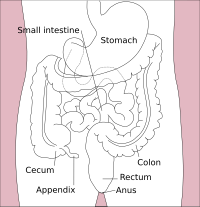Jejunum
| Jejunum | |
|---|---|
vagus[1] | |
| Identifiers | |
| Latin | jejunum |
| MeSH | D007583 |
| TA98 | A05.6.03.001 |
| TA2 | 2958 |
| FMA | 7207 |
| Anatomical terminology] | |
 |
| Major parts of the |
| Gastrointestinal tract |
|---|
The jejunum is the second part of the
The jejunum lies between the
Structure
The interior surface of the jejunum—which is exposed to ingested food—is covered in finger–like projections of mucosa, called villi, which increase the surface area of tissue available to absorb nutrients from ingested foodstuffs. The epithelial cells which line these villi have microvilli. The transport of nutrients across epithelial cells through the jejunum and ileum includes the passive transport of sugar fructose and the active transport of amino acids, small peptides, vitamins, and most glucose. The villi in the jejunum are much longer than in the duodenum or ileum.
The
The jejunum and the ileum are suspended by mesentery which gives the bowel great mobility within the abdomen. It also contains circular and longitudinal smooth muscle which helps to move food along by a process known as peristalsis.
Histology
The jejunum contains very few
There is no line of demarcation between the jejunum and the ileum. However, there are subtle
- The jejunum has less fat inside its mesentery than the ileum.
- The jejunum is typically of larger diameter than the ileum.
- The villi of the jejunum look like long, finger-like projections, and are a histologically identifiable structure.
- While the length of the entire intestinal tract contains lymphoid nodules that contain large numbers of lymphocytes and immune cells, like microfold cells.
-
Transmission electron microscope (TEM) image of human jejunum
-
TEM image of mouse jejunum (14,000-fold magnification)
-
Dog jejunum (magnified 100-fold)
Function
The lining of the jejunum is specialized for the absorption by
Other animals
In fish, the divisions of the small intestine are not as clear and the terms middle intestine or mid-gut may be used instead of jejunum.[7]
History
Etymology
Jejunum is derived from the Latin word jējūnus (iēiūnus), meaning "fasting." It was so called because this part of the small intestine was frequently found to be void of food following death,[8] due to its intensive peristaltic activity relative to the duodenum and ileum.
The Early Modern English adjective jejune is derived from the same root.[9]
References
- ^ Nosek, Thomas M. "Section 6/6ch2/s6ch2_30". Essentials of Human Physiology. Archived from the original on 2016-03-24.
- OED2nd edition, 1989.
- ^ Entry "jejunum" in Merriam-Webster Online Dictionary.
- ^ ISBN 978-0-8089-2306-0.
- ISBN 978-0-443-068-508.
- PMID 13696269.
- ^
Guillaume, Jean; Praxis Publishing; Sadasivam Kaushik; Pierre Bergot; Robert Metailler (2001). Nutrition and Feeding of Fish and Crustaceans. Springer. p. 31. ISBN 9781852332419. Retrieved 2009-01-09.
- ^ Harper, Douglas. "jejunum". Etymology Online. Retrieved 15 November 2014.
- ^ "Oxford English Dictionary: jejune, adj".
External links
- Gastrolab.net:The Jejunum
- Peyer's patches Archived 2016-03-04 at the Wayback Machine
- Anatomy photo:37:11-0100 at the SUNY Downstate Medical Center – "Abdominal Cavity: The Jejunum and the Ileum"
- Anatomy image:7856 at the SUNY Downstate Medical Center



